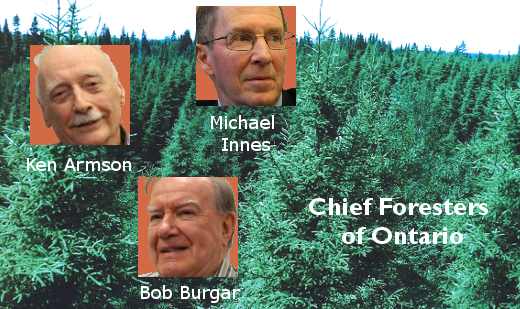
When visitors fly over Ontario, they are often surprised and delighted by how much of the province is covered by trees. Ontarians are justly proud of the province’s forests as a source of jobs and wealth. With the growth of environmentalism, Ontario’s forests are also a natural resource treasure that needs to be well managed.
Ken Armson was Ontario’s Provincial Forester and is now Chair of the Forest History Society of Ontario. Robert J. Burgar was Assistant Deputy Minister at the Ministry of Natural Resources. Michael Innes was a forester for the Ministry in both northern and southern Ontario before joining the Abitibi-Price paper company and then serving as Vice President, Environment for Abitibi-Bowater in Montreal before his retirement.
Together these three foresters have amassed a huge base of knowledge and detailed stories about what they first encountered as young foresters and what they learned, which benefits everyone today.
In 1994 the Crown Forest Sustainability Act (CFSA) was passed, reflecting newer thinking about forests, putting overall environmental considerations into forest management. However, foresters like Armson, Burgar and Innes were thinking about these issues long before the Act was passed. The same year, Minister of Natural Resources appointed a Council on Forest Sector Competitiveness made up of representatives from industry, municipalities, First Nations, environmental groups and independent advisors. The Council recommended establishing the position of Chief Forester to oversee the research and knowledge about our forests and how they are being managed (though no action was taken).
History of Forestry in Ontario
Forestry thinking had been evolving since European settlers began to flock to what was known as Upper Canada (now Ontario) beginning in the late 19th century and into the 20th. Before Canada became a nation on July 1, 1867, the forests were thought to be inexhaustible. In southern Ontario, settlers cleared land for farming and building towns and cities. Forests in northern Ontario seemed to be a vast and endless supply of timber that would always be there for the taking. Trees from Crown land (publicly-owned forests) could be harvested by any person or company licensed by the Crown. Ontario has more than 71 million hectares of forest, and 90 per cent of this is Crown forest. In the 19th century and most of the 20th century, the rights of Ontario’s First Nations as far as ownership and use of these forests was concerned was often neglected or ignored, a situation that is beginning to be addressed only now. In the late 1800s, the British Royal Navy reserved the right to take oak and timber for shipbuilding. By 1826 Ontario’s colonial rulers imposed a law: all species of trees could be cut, but anyone who harvested Crown forests had to pay a stumpage, or licence fee, to the government. A version of the stumpage system remains in effect to this day: Ontario’s forestry industry pays the province an average of $240 million a year for the use of Crown timber. By the end of the 19th century, as Ontario grew and the railroads were built, the public, governments and those involved in harvesting forests began to be concerned about new issues. Would there always be access to top-quality wood in Ontario? How do we protect forests from wildfires? What tree species are in Ontario’s different forests, and what’s the best way to replenish our forests? By 1900, many areas in southern Ontario had been cleared and improperly farmed on lands susceptible to erosion. Hard as it may be to imagine, parts of the province were being turned into desert — wildlife disappeared, rivers and wetlands dried up and the topsoil blew away. Other areas, denuded of trees, became susceptible to floods. In 1904, Edmund Zavitz, a lecturer in Forestry at the Ontario Agricultural College in Guelph, surveyed these so-called “wastelands” and as a result of this a provincial nursery was opened at St. Williams in 1908 to provide trees for replanting such areas. This was the beginning of a major program of reforestation in southern Ontario. Many farmers listened and began planting trees, and the provincial government named Zavitz as one of Ontario’s first Provincial Foresters. (Zavitz succeeded Dr. Judson Clark as Provincial Forester, who served from 1905 to 1906.) In 1926, Zavitz became Ontario’s Deputy Minister of Forestry. By the mid-1940s, under Zavitz’s guidance, reforestation was an established practice. By the time of his death in 1968, one billion trees had been planted in Ontario — an additional two billion have been planted since then. One of Zavitz’s big acheivements was also to secure legislation preventing clear cutting on private land — a law that has done a lot to protect the province’s forest cover. Technology has been a part of forestry in Ontario since the days of Zavitz’s photographs. Until the airplane was perfected, the only way to survey Ontario’s forests was on the ground. As technology advanced through the 20th and into the 21st century, forestry, surveying and inventory taking of Ontario’s trees grew into a highly skilled, technical profession. Foresters used aerial surveillance, specialized film and digital photography. By the 1990s, mapping and detailed information gathering by remote sensing of forests and soil composition was completed using satellite data. Ontario’s foresters were at the vanguard of all these advances, and Armson (who served as Provincial Forester from 1986-89), Innes and Burgar are among those who have carried on Zavitz’s legacy. Though there is no formal position of Chief Forester in Ontario, experts like these continue to work hard to protect Ontario’s trees. They’ve looked at every aspect of forestry, travelling to other provinces and other timber-rich regions such as Scandinavia to compare practices, studying soils, tree species, harvesting and replenishing methods.Educating the public
Perhaps most importantly, the foresters learned that dialogue was important. Most people in Ontario live far away from the province’s large Crown forests, and have little idea of what goes into forest management. The foresters understood that people had strong views about forestry values — regeneration, protecting wildlife, making sure areas are attractive for tourists and so on. Their task was to address the difficult questions, based on sound science and policy. What kind of regeneration is best? Who should pay for it? Who will do the work? Over time, they went from confrontations with environmentalists to a pattern of sitting down and seeing how they could reach consensus and agreement. In places like Simcoe County we can see the legacy of Ontario’s foresters; by championing the planting of trees they were successful in protecting the area from becoming windblown and lifeless. These important forestry experts laid the groundwork for the Forest Management Agreements under the Crown Forest Sustainability Act. These agreements establish how Ontario’s timber is managed. They came about under an amended Crown Timber Act (CTA) of 1980, which established how Crown forests would be managed by the major licensees of Crown timber. The Crown Forest Sustainability Act in 1994 superseded the CTA. As Ken Armson says:Only by being knowledgeable of the history of the use and development of our forests and the landscape and soils on which they occur can we make intelligent decisions about their current and future development and uses.
